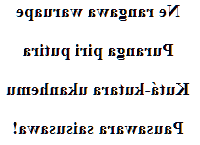Nheengatu love poem
Waruá
Ne rangawa waruape
Puranga piri putira
Kutá-kutara ukanhemu
Pausawara saisusawa!
(I tried to keep short verses with the same number of syllables in my version,
to get a rhythm like in the original, and it is a little more abstract)

Literal translation
Ne rangawa waruape
Aé se nheeputira puranga piri waá
Ma resú kutara, aé ukanhemu
Aé se pausawara "asaisú indé"!
Two other versions
Ne rãgawa waruá pe
I çe r'açã katupiri
Maari indé munhã piriri poté o apagari.
Kuá i çe ayuni a çaiçú indé
Yaguarê Yamã Aripunãguá (Nheengatu Language Academy)!
Nerãgawa waruá upé
Serasã katupiri
Ma inde remunhã piriri puti uapagari
Ou seayuni sei
Yaguarê Yamã Aripunãguá (Nheengatu Language Academy)!
Last sentence means: "That is my last good bye"!

→ French poem ←
Nhengatu language
Nhengatu (Nhe'engatu, Nheengatu, Ñe'engatú, lingua geral Amazônica) is a Tupi language from Amazonia, based on Tupinambá. We estimate its number of speakers, in Brazil, Colombia and Venezuela, at perhaps 30,000 people. After being widely used until the 19th century, its number of speakers has declined in favor of Portuguese, until in 2003 when it became a co-official language in São Gabriel da Cachoeira.
According to Professor Yaguarê Yamã Aripunãguá of the Academia da Língua Nheengatu (Nheengatu Language Academy), Brazil, there are three spoken variations of Nheengatu: Nheengatu do Rio negro, Nheengatu traditional, Nheengatu do Tapajós. Speakers of these three Nheengatu variations can orally communicate amongst themselves with varying degrees of difficulties. The spelling of the three variants differs, which makes comprehension of these different reading almost insurmountable.
Origin of Nheengatu
When the Portuguese began to enter the Amazon and exploit its riches, their workforce was a collection of Indians of different tribes who spoke distinct Tupi languages. Under the impulse of missionaries, a lingua franca, Tupi, was then unified through a creolization based on Tupinambá. It is this language, Nheengatu (the general language of Amazonia), which will become the language of communication in Amazonia. Nheengatu means "good speak".